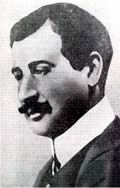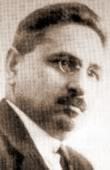Glossary (Varazdat – Zvartnots)
Varazdat
King of Armenia (384-386), nephew of King Papes. Historians describe him as a handsome and athletic young man. According to tradition, he took part in one of the last Olympic Games (before Theodosius the Great abolished them in 394), and won the fisticuffs contest. As a ruler, Varazdat is given less flattering description. He wished to marry the Persian princess, which incurred displeasure of the Roman Emperor and ruptured the Roman support of Armenia. Also, Varazdat perfidiously assassinated Mushegh Mamikonyan, Sparapet and renowned hero, which caused indignation and rebellion of the grandees. Varazdat was then defeated in a battle by Manvel, Mushegh’s brother, and was forced to flee the country. Later, Theodosius the Great captured him to exile to an island.
Vardan Mamikonyan
 St.Vardan statue in Yerevan, by Ervand Kochar, 1975
St.Vardan statue in Yerevan, by Ervand Kochar, 1975
Also: St.Vardan, Prince, Sparabet of Armenia. In 451, he headed the famous uprising of the Armenian nobles against Persia known as Vardanank. The Persian king Yezdiguert II invaded Armenia to destroy Christianity and to convert Armenia into Zoroastrianism. The deciding battle took place on May 26, 451 in Avarayr place of the Artaz canton, in Vaspurakan. Vasak Siuni, Armenian Prince-traitor was fighting for the Persians. Vardan among many other Armenian nobles fell in the battle. He was then canonized and the day of the Saint Martyrs of Avarayr is celebrated in the Armenian Church to this day.
Vardan the Great
(Vardan Areveltsi) Armenian scholar, theologian, fabulist and historian of 13-th century, author of Universal History. His work is a precious source for study of the period of the Mongol invasions.
Varujan, Daniel
 Daniel Varujan
Daniel Varujan
(1884-1915) Great poet of the Western Armenia, author of lyric and epic poems, such as The Heart of the Race, Pagan Songs, Songs of Bread and others. He was arrested, among many others on April 24, 1915 and then killed on August 26, 1915.
Vazgen I
 Vazgen I
Vazgen I
(Vasken Baljian) Catholicos of all Armenians from 1955 to 1994. He played important role in creating closer ties between Soviet Armenia and the Armenians of Diaspora. He could achieve a greater degree of independence from the communist authorities as compared with the churches in other republics of the Soviet Union. Under Vazgen I, the Armenian Church joined the World Council of Churches.
Vaspurakan
Vast province of the historical Great Armenia, situated east and northeast to the Van Lake. Vaspurakan was one of 15 ashkars (worlds) and consisted of 35 cantons: Rchtounik, Tosb, Bogunik, Archishaovit, Aghiovit, Kughanovit, Arberani, Darni, Bujnunik, Arnoyotn, Andzevatzik, Atrpatunik, Ervandunik, Mardastan, Artaz, Akeh, Metz Aghbak, Andzakhidzor, Tornavan, Tchevashrot, Kirchunik, Metznunik, Palounik, Gukan, Aghvandrot, Patspatounik, Artashesian, Artavanian, Bagan, Gavityan, Gazrikan, Taygirian, Varajnunik, Gokhten and Nakhichevan.
Vratsian, Simon
 Simon Vratsian
Simon Vratsian
(1882-1969) (Krouzinian) Armenian writer and statesman. He was Prime Minister of Armenia in 1920. His six volume Memoirs is the detailed account of the establishment and history of the First Republic of Armenia.
Vyrk
The Armenians called so the Eastern Georgia (Iveria).
Yerevan
(Erevan), capital and largest city of today’s Republic of Armenia. The fact of its foundation in 782 BC by King Argiste is registered in a cuneiform inscription.
Zakaryan
Armenian noble family that became especially powerful in the 12-13th centuries. After the fall of the Armenian Kingdom in the Greater Armenia, many Armenian princes joined the reinforcing Georgian Kingdom ruled by a branch of Bagratuni dynasty. The united Armenian and Georgian forces led by brothers Zakare and Ivane Zakaryan retook numerous Armenian castles and cities, among them Ani, Dvin and Kars from the Turks. Zakare and Ivane were the most influential nobles in the court of Queen Tamar (1184-1213).
Zangezour
Region of Armenia (present day southeast Republic of Armenia), approximately corresponds to the historical Siunik province. According to Stephanos Orbelian, etymologically, Zanguezour derived from Dzaguezor (Armenian for Canyon of Dzag). Dzag was the ancient patriarch of Siunik, offspring of Sisak.
Zvartnots
(Temple of Vigil Force) Cathedral built in 661 by Catholicos Nerses III on the old road between Vagharshapat and Artashat cities, right where, according to tradition, King Tiridates met Gregory the Illuminator. The somptuous church, jewel of the early medieval architecture, was destroyed in the 10th century during an earthquake. The ruins of Zvartnots and the adjacent Patriarchal palace are preserved as an historic site near the present city of Echmiadzin.







